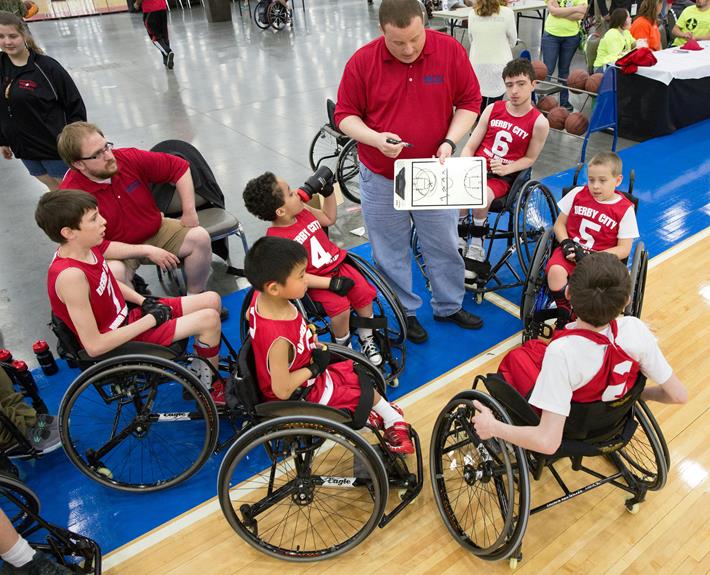What Is Transition in Basketball?
Movement in basketball involves quick transitions between defense and offense, relying on speed, teamwork, and strategic decision-making to outperform opponents.
Teams capitalize on opportunities by swiftly moving up the court and exploiting defensive gaps. Offensive strategies such as the Primary Break emphasize speed, while the Secondary Break offers structured plays.
The Numbered Fast Break is used to take advantage of numerical superiority. Defensively, teams focus on quick backtracking, pressuring ball handlers, and maintaining strategic positioning to disrupt opponents.
Scoring opportunities often stem from creating chaos in the opponent’s defense, executing fast breaks, driving to the basket, and creating numerical advantages for higher percentage shots.
Improving your understanding of movement play can be achieved through practicing various offensive drills and mastering execution for a more successful basketball performance.
Key Takeaways
- Transition in basketball involves swiftly moving from defense to offense to capitalize on scoring opportunities.
- It requires speed, teamwork, and quick decision-making to exploit gaps in the opponent’s defense.
- Offensive strategies include primary break, secondary break, numbered fast break, and breakaway finishes for efficient scoring.
- Defensive tactics involve quick backtracking, pressuring the ball handler, awareness of opponents, communication, and smart positioning.
- Scoring chances in transition come from opponent disorganization, fast breaks, driving to the hoop, exploiting weaknesses, and creating numerical advantages.
Transition Basics in Basketball
Shifting in basketball involves rapidly changing from defense to offense, seizing on opportunities to score before the opposing team can establish their defense. Transformation basketball is all about the quick change from stopping the opponent to scoring on them.
It’s like a race up the court, aiming to catch the defense off guard and create scoring chances before they can regroup.
Fast breaks are vital in transformation play, allowing your team to capitalize on the momentary defensive disarray. The key to successful transformation basketball lies in exploiting the gaps in the opponent’s defense, pushing the pace, and making quick decisions to maximize scoring opportunities.
Transformation play demands speed, teamwork, and sharp decision-making skills to convert defensive stops into offensive points efficiently.
Offensive Transition Strategies
To thrive in offensive metamorphosis in basketball, you must promptly change from defense to offense to capitalize on scoring opportunities efficiently.
Here are some offensive strategies to boost your shift offense in basketball:
- Primary Break: Utilize speed to push the ball up the court quickly after a defensive stop, catching opponents off guard.
- Secondary Break: Transition into a structured offensive set if the primary break doesn’t lead to easy scoring options.
- Numbered Fast Break: Use numerical advantages to create open players and high-percentage scoring opportunities.
- Breakaway Finishes: Capitalize on fast breaks resulting from defensive pressure to secure easy baskets.
Defensive Transition Tactics
Incorporating rapid defensive shifts is essential for disrupting opponents’ offensive momentum and securing key stops in basketball.
During defensive progression, players must quickly backtrack to prevent the offensive team from capitalizing on scoring opportunities. It is important to focus on pressuring the ball handler to disrupt their flow and limit their options.
Maintaining awareness of opponents’ movements and communicating effectively with fellow defenders are critical components of successful defensive progression tactics.
As defenders often face numerical disadvantages in these situations, strategic positioning and smart decision-making play a significant role.
Discipline, teamwork, and defensive coordination are key elements that contribute to effective defensive progression strategies in basketball.
| Defensive Progression Tactics | |
|---|---|
| Quick Backtracking after Turnover | Pressure on Ball Handler |
| Awareness of Opponents’ Movements | Effective Communication |
| Strategic Positioning | Smart Decision-Making |
| Discipline, Teamwork, and Coordination | Numerical Disadvantages |
Scoring Opportunities in Transition
When moving swiftly from defense to offense in basketball, be alert for scoring opportunities that capitalize on the opponent’s disorganization. Fast break plays offer chances for quick points before the defense can set up.
Here are some key ways to identify and take advantage of scoring opportunities in the rapid change of play:
- Fast Breaks: Look to push the ball up the court quickly after a defensive stop to catch the opponents off guard.
- Easy Baskets: Seek out open lanes to drive to the hoop for high-percentage scoring chances.
- Exploiting Defensive Weaknesses: Identify mismatches or slow defenders to attack for easy points.
- Creating Numerical Advantages: Utilize passing and movement to create 2-on-1 or 3-on-2 situations for better scoring opportunities.
Transition Offense Drills
Fast break offense drills are vital for honing players’ skills in quick break strategies shifting from defense to offense.
These drills help players take advantage of fast break opportunities, where offensive players move quickly to score before the defense is set.
By practicing these drills, players learn to make split-second decisions, coordinate movements efficiently, and exploit defensive weaknesses for scoring chances.
During these exercises, players practice sprinting down the court, receiving passes on the move, and attacking towards the basket with speed and precision.
Quick break offense drills are essential for developing a fast-paced and effective fast break game, enhancing players’ ability to convert turnovers or defensive stops into quick offensive plays and scoring opportunities.
Running an Effective Transition Offense
To excel in running an effective fast break offense in basketball, focus on exploiting defensive disorganization for quick scoring chances. When executing a swift offensive play, players need to work together seamlessly to capitalize on the chaos caused by the retreating defensive team.
Here are some key strategies to enhance your fast break offense:
- Quick Ball Movement: The ball handler should push the ball up the court swiftly to catch the defensive team off guard.
- Spacing: Offensive players need to spread out effectively to create passing lanes and open opportunities for scoring.
- Decision Making: Players must make rapid and smart decisions to take advantage of defensive vulnerabilities.
- Speed and Precision: Execution in fast break offense demands speed and accuracy to convert fast break opportunities into points efficiently.
Transition Basketball Plays Overview
In fast break basketball plays, effective coordination and tactical passing are essential for capitalizing on scoring opportunities quickly.
Breakneck basketball involves swiftly moving from defense to offense, exploiting the moment when the opposing defense isn’t fully set.
Maintaining proper spacing is vital to create lanes for driving to the basket or taking open shots.
Quick decision-making plays a significant role in breakneck, as players must assess the defense and make split-second choices to advance the ball efficiently.
Fast break plays often focus on passing to the point guard, who acts as the orchestrator of the fast break, setting up teammates for scoring chances.
By balancing speed with control and ensuring good spacing, teams can effectively execute breakneck plays and catch the defense off guard.
Executing Transition Plays Successfully
When executing fast break plays successfully in basketball, rapid passing to the point guard is essential to kickstarting the offense effectively. Here’s how you can guarantee your transition plays flow smoothly:
- Quick Decision-making: Evaluate the court and pass to the point guard as swiftly as possible.
- Spacing: Establish good spacing to avoid crowding, allowing for efficient ball movement.
- Exploiting Gaps: Identify defensive players out of position and attack those gaps for scoring opportunities.
- Coordinated Movement: Move as a unified unit to outpace the defense and create easy scoring chances.
Examples of Transition Offense Set Plays
Explore various quick break offense set plays like ball screens, double screens, flares, and back screens to seize fast break opportunities effectively.
When your team is in motion, utilizing ball screens can create openings for a teammate to drive to the basket or take an open shot.
Double screens involve two players setting screens simultaneously, confusing the defense and freeing up shooters.
Flares are effective for perimeter players, as they swiftly move to the three-point line for a shot.
Back screens catch the defense off guard as a player cuts backdoor for a potential layup.
By integrating these plays into your fast-paced offense, your team can take advantage of quick break situations and score efficiently.
Frequently Asked Questions
What Does It Mean to Score in Transition in Basketball?
To score in fast break in basketball, you need to exploit quick break opportunities by swiftly moving the ball up the court after a defensive stop. This catches opponents off-guard, creating high-percentage scoring chances like layups and open shots.
What Is a Transition Take in Basketball?
In basketball, a shift take means swiftly shifting from defense to offense. You need speed, awareness, and teamwork to capitalize on a disorganized defense. It’s about catching opponents off guard, creating scoring chances, and making quick plays.
How Do You Run Transitions in Basketball?
To execute changes in basketball, you sprint up the court, fill lanes, and communicate. Stay spread out to exploit openings and score fast. Keep turnovers low and catch opponents off guard for quick points.
What Does It Mean to Run in Transition?
Running in fast break means swiftly advancing the ball up the court after a defensive stop or turnover. It involves pushing the tempo to catch the defense off guard, create scoring opportunities, and exploit defensive vulnerabilities.
Conclusion
To sum up, mastering the art of change in basketball is essential for success on the court. By utilizing offensive and defensive strategies, identifying scoring opportunities, and practicing effective drills, teams can excel in fast-paced gameplay.
Keep in mind, quick decision-making and seamless execution are vital to shifting smoothly between offense and defense. Keep refining your skills and perfecting your plays to dominate the game with speed and precision.
Keep pushing forward, and victory will be within reach.












